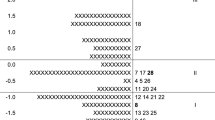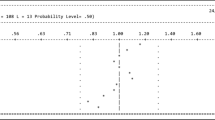Abstract
The aim of this study was to develop a scale which can be used to measure the computational thinking skills (CTS) of high school students. Validity and reliability testing of the scale was performed with the participation of 785 students. Exploratory and confirmatory factor analysis showed that the five-point Likert scale had a construct consisting of four factors Problem-solving, Cooperative Learning & Critical Thinking, Creative Thinking, and Algorithmic Thinking expressed by 42 items. The factor loadings of the scale varied from .475 to .853. The confirmatory factor analysis performed to reveal the factorial validity of the scale showed that the Chi-square value (χ2 = 2679.07; sd = 815, p = 0.00) was significant. The fitness index values were found to be RMSA = .0075; SRMR = .081; NNFI = .91; CFI = .92; GFI = .90; and AGFI = .88. The Cronbach’s Alpha internal consistency coefficient was .969 for the overall scale. In addition, the stability of the scale was examined to obtain information about its reliability and the test-re-test method was used. It was concluded as a result of the analysis that the scale was a valid and reliable measurement tool which can be used to measure the CTS of high school students.


Similar content being viewed by others
References
Amabile, T. M. (1985). Motivation and creativity: Effects of motivational orientation on creative writers. Journal of Personality and Social Psychology, 48(2), 393–399.
Anderson, C. W., & Smith, E. L. (1984). Children's preconceptions and content-area textbooks in G.G. Duffy. Comprehension Instruction Perspectives and Suggestions. New York: Longman.
Ater-Kranov, A., Bryant, R., Orr, G., Wallace, S., & Zhang, M. (2010). Developing a community definition and teaching modules for computational thinking: Accomplishments and challenges. Proceedings of the 2010 ACM Conference on Information Technology Education, 143–148.
Atmatzidou, S., & Demetriadis, S. (2016). Advancing students’ computational thinking skills through educational robotics : A study on age and gender relevant differences. Robotics and Autonomous Systems, 75, 661–670. https://doi.org/10.1016/j.robot.2015.10.008.
Balcı, A. (2009). Research in Social Sciences: Methods, Techniques and Principles. Ankara: Pegem A.
Barr, D., Harrison, J., & Conery, L. (2011). Computational thinking: A digital age skill for everyone. Retrieved from: http://files.eric.ed.gov/fulltext/EJ918910.pdf.
Bati, H. (2017). Computational thinking and integrative education (STEAM) in science education. Pamukkale University Journal of Education, 41, 91–103. https://doi.org/10.9779/PUJE800.
Berkeley, (2017). The beauty and joy of computing. Retrieved from: http://bjc.berkeley.edu
Boden, M. A. (1998) What is creativity, creativity in human evolution and prehistory (1 ed.). Steven J. Mithen, Routledge.
Brennan, K., & Resnick, M. (2012). New frameworks for studying and assessing the development of computational thinking. 2012 annual meeting of the american educational research association (Vancouver: Canada). Retrieved from: http://scratched.gse.harvard.edu/ct/files/AERA2012.pdf.
Bundy, A. (2007). Computational thinking is pervasive. Retrieved from: http://www.inf.ed.ac.uk/publications/online/1245.pdf.
Büyüköztürk, Ş. (2002). Data analysis handbook. Ankara: Pegem Publication.
Büyüköztürk, Ş. (2008). Manual of data analysis for social sciences. Ankara: Pegem A Publications.
Büyüköztürk, Ş., Çakmak, E. K., Akgün, Ö. E., Karadeniz, Ş., & Demirel, F. (2015). Scientific research methods. Ankara: Pegem A Publications.
Carmines, E. G., & Zeller, R. A. (1982). Reliability and validity assessment (5th ed.). Beverly Hills: Sage Publications Inc..
Chaffee, J. (1994). Thinking critically. Boston: Houghton Mifflin.
Chen, G., Shen, J., Barth-Cohen, L., Jiang, S., Huang, X., & Eltoukhy, M. (2017). Assessing elementary students’ computational thinking in everyday reasoning and robotics programming. Computers & Education, 109, 162–175. https://doi.org/10.1016/j.compedu.2017.03.001.
Code.org. (2017). Hour of code. Retrieved from: https://hourofcode.com/tr/gb.
Cooper, S., Dann, W., & Pausch, R. (2000). Developing algorithmic thinking with Alice. In Proceedings of Isecon, 17, 506–539.
Craft, A. (2003). Creative thinking in the early years of education. Early Years, 23(2), 143–154.
Cropley, A. (2001). Creativity in education and Learning Great Britain: Clays.
Curzon, P. (2015). Computational thinking: Searching to speak. Retrieved from: http://teachinglondoncomputing.org/free-workshops/computational-thinking-searching-to-speak/.
Czerkawski, B. C., & Lyman III, E. W. (2015). Exploring issues about computational thinking in higher education. Tech Trends, 59(2), 57–65. https://doi.org/10.1007/s11528-015-0840-3.
Demir, Ö., & Seferoğlu, S. S. (2017). New concepts, different uses: An evaluation related to computational thinking. Readings of Educational Technology, 41(August), 468–483.
Department for Education England (2013). National curriculum in England:Computing programmes of study key stages 1 and 2. Ref: DFE-00171e2013. Retrieved from: https://www.gov.uk/government/publications/nationalcurriculum-in-england-computing-programmes-of-study.
Ennis, R. H. (1962). A concept of critical thinking. Havard Educational Review, 22, 88–111.
Fabrigar, L. R., Wegener, D. T., MacCallum, R. C., & Strahan, E. J. (1999). Evaluating the use of exploratory factor analysis in psychological research. Psychological Methods, 4(3), 272–299.
Facione, P. A., & Facione, N. C. (1993). Test Manual: the California Critical Thinking Skills Test, Form A and Form B. Millbrae: The California Academic Press.
Facione, N. C., Facione, P. A., & Sanchez, C. A. (1994). Critical thinking disposition as a measure of competent clinical judgement: The development of the California thinking disposition inventory. Journal of Nursing Education, 33, 345–350.
Fisher, R. (2004). Creativity across the curriculum. In R. Fisher & M. Williams (Eds.), In unlocking reativity (pp. 160–172). Britain: David Fulton.
Gelbal, S. (1991). Problem solving. Hacettepe University Journal of Education, 6, 167–173.
Gorsuch, R. L. (1983). Factor analysis (2. ed.). Hillsdale: Lawrence Erlbaum Associates.
Guilford, J. P. (1967). Creativity: Yesterday, today and tomorrow. The Journal of Creative Behavior, 1(1), 3–14.
Halpern, D. F. (2013). Thought and knowledge: An introduction to critical thinking. New York: Psychology Press.
Harvard (2017). CS50: Introduction to computer science. Retrieved from: https://cs50.harvard.edu
Heppner, P. P., & Krauskopf, C. J. (1987). The integration of personal problem solving processes within counseling counsel. Psychologist, 15, 371–447.
Heppner, P. P., & Reeder, L. (1983). The relationship between problem solving self-appraisal and psychological adjustment. Cognitive Therapy and Research, 9(4), 415–427.
Heppner, P. P., Baumgardner, A. H., & Jakson, J. (1985). Depression and attributional style: Are they related? Cognitive Therapy and Research, 9, 105–113.
Hu, C. (2011). Computational thinking: What it might meanand what we might do about it. In M. Goldweber (Ed.), 16th annual joint conference on Inno-vation and Technology in Computer Science Education (pp. 223–227). New York: ACM.
Hu, L., & Bentler, P. M. (1999). Cutoff criteria for fit indexes in covariance structure analysis: Conventional criteria versus new alternatives. Structural Equation Modeling, 6, 1–55.
ISTE (2015). Computational thinking leadership toolkit (First Edition). Retrieved from: https://www.iste.org/explore/articleDetail?articleid=152&category=Solutions&article=Computational-thinking-for-all.
ISTE (2016). ISTE standards for students. Retrieved from: https://www.iste.org/standards/standards/for-students-2016.
ISTE-CSTA (2011). Computational thinking: Teacher resources (2. edition) (Grant No: CNS-1030054). Retrieved from: https://www.iste.org/explore/articleDetail?articleid=152&category=Solutions&article=Computational-thinking-for-all.
Jane, L. (2001). The relationship between social problem solving and bullying behaviour among male and female adult prisoners. Aggresive Behavior, 27, 297–312.
Johnson, D.W., & Johnson, R.T. (1994). Leading the cooperative school. (Second edition), Edina, Minnesota: Interaction Book Company.
Johnson, D. W., & Johnson, R. T. (1995). Creative controversy: Intellectual challenge in the classroom. Edina: Interaction Book Company.
Johnson, D. W., Johnson, R. T., & Holubec, E. J. (1994). The nuts & bolts of cooperative learning. In Edina. Minnesota: Interaction Book Company.
Jöreskog, K., & Sörbom, D. (1993). Lisrel 8: Structural equation modeling with the Simplis command language. USA: Scientific Software International.
Kalaycı, Ş. (2009). SPSS applied multivariate statistical techniques. Ankara: Asil Publication.
Katai, Z. (2015). The challenge of promoting algorithmic thinking of both sciences- and humanities-oriented learners. Journal of Computer Assisted Learning, 31(4), 287–299. https://doi.org/10.1111/jcal.12070.
Kazimoglu, C., Kiernan, M., Bacon, L., & MacKinnon, L. (2012). Learning programming at the computational thinking level via digital game-play. Procedia Computer Science, 9, 522–531. https://doi.org/10.1016/j.procs.2012.04.056.
Kline, R. B. (2005). Structural equation modeling (2nd ed.). New York: The Guilford Press.
Knuth, D.E. (1980). Algorithms in modern mathematics and computer Science Stanford Department of Computer Science Report No. STAN-CS-80-786, 1980.
Korkmaz, Ö., Çakir, R., & Özden, M. Y. (2017). A validity and reliability study of the computational thinking scales (CTS). Computers in Education, 72, 558–569. https://doi.org/10.1016/j.chb.2017.01.005.
Lau, J. Y. (2011). An introduction to critical thinking and creativity: Think more, think better. Wiley.
Lee, T. Y., Mauriello, M. L., Ahn, J., & Bederson, B. B. (2014). CTArcade: Computational thinking with games in school age children. International Journal of Child-Computer Interaction, 2(1), 26–33. https://doi.org/10.1016/j.ijcci.2014.06.003.
Lu, J. J., & Fletcher, G. H. L. (2009). Thinking about computational thinking. ACM Special Interest Group on Computer Science Education Conference (SIGCSE 2009). Chattanooga: ACM Press.
Mayer, R. E. (1992). Thinking, problem solving, Cognition. New York: W H Freeman and Company.
Mayer, R. E. (1998). Cognitive , metacognitive , and motivational aspects of problem solving. Instructional Science, 26(1–2), 49–63. https://doi.org/10.1023/A:1003088013286.
Mayer, R. E. (1999). Fifity years of creativiy research. Ed by Robert J. Handbook of creativity, Sternberg, Cambridge University Press.
National Research Council. (1999). Being fluent with infor-mation technology. Washington, DC: National AcademyPress.
Newell, A., & Simon, H. A. (1972). Human problem solving (Vol. 104, No. 9). Englewood Cliffs, NJ: Prentice-Hall.
Papert, S. (1996). An exploration in the space of mathematics educations. International Journal of Computers for Mathematical Learning, 1(1), 95–123.
Paul, R. W. (1984). Critical thinking fundamental to education for a free society. Educational Leadership, 1, 5–14.
Paul, R. (1990). Critical thinking. In Rohnert Park. California: Sonoma State University.
Piirto, J. (2004). Understanding creativity. Great potential press, Inc. In USA.
Rouquette, M. L. (2007). Creativity . Ankara: Dost.
Şahiner, A., & Kert, S. B. (2016). Examining studies related with the concept of computational thinking between the years of 2006-2015. European Journal of Science and Technology, 5(9), 38–43.
Seçer, İ. (2013). Practical data analysis and reporting with SPSS and LISREL. Ankara: Anı Publication.
Seferoğlu, S., & Akbıyık, C. (2006). Critical thinking and teaching. Hacettepe Universitesi Journal of Education, 30, 193–200. https://doi.org/10.1080/03634526109377142.
Simpson, E., & Courtney, M. (2002). Critical thinking in nursing education: Literature review. International Journal of Nursing Practice, 8, 89–98.
Şimşek, Ö. F. (2007). Introduction to Structural Equation Modeling; Basic Principles and LISREL Applications. Ankara: Ekinoks Press.
Slavin, R. E. (1980). Cooperative learning: Theory research and Practice. Rentice Hall: Englewood Cliffs.
Slavin, R. E. (1987). Cooperative learning in student teams: What research says to the teacher. Washington, D.C.: National Education Association.
Sönmez, V., & Alacapınar, G. F. (2014). Sampled scientific research methods. Ankara: Anı Publication.
Sternberg, R. J., & Lubart, T. I. (1999). The concept of creativity: Prospects and paradigms. In R. J. Sternberg (Ed.), Handbook of creativity (pp. 3–15). Cambridge: Cambridge University Press.
Tavşancıl, E. (2002). Attitude Measurement and Data Analysis with SPSS. Ankara: Nobel Publications.
Thornton, S. (1998). Kids solve the problem. Istanbul: Gendaş Publishing.
Turgut, M. F., & Baykul, Y. (2011). Measurement and evaluation in education. Ankara: PegemA Publication.
Vee, A. (2013). Understanding computer programming as a literacy. Literacy in Composition Studies, 1(2), 42e64.
Veenman, S., Benthum, N., Bootsma, D., Dieren, J., & Kemp, N. (2002). Cooperative learning and teacher education. Teaching and Teacher Education, 18, 87–103.
Veneziano, L., & Hooper, J. (1997). A method for quantifying content validity of health-related questionnaires. American Journal of Health Behavior, 21(1), 67–70.
Watson, G., & Glaser, E. M. (1980). Watson-Glaser Critical Thinking Appraisal. San Antonio: The Psychological Corporation.
Wing, J. M. (2006). Computational thinking. Communications of the ACM, 49(3), 33–35.
Wing, J. M. (2008). Computational thinking and thinking about computing. Philosophical Transactions of the Royal Society, 366, 3717–3725.
Wing, J. M. (2011). Research notebook: Computational thinking What and why? The Link Magazine, Spring. Carnegie Mellon University, Pittsburgh. Retrieved from: https://www.cs.cmu.edu/link/research-notebook-computational-thinking-what-and-why.
Wing, J. M. (2016). Computational thinking. 10 years later. Microsoft Research blog. Retrieved from: https://www.microsoft.com/en-us/research/blog/computational-thinking-10-years-later/.
Wolfram, S. (2016). How to teach computational thinking. Blog Stephen Wolfram. Retrieved from: http://blog.stephenwolfram.com/2016/09/how-to-teachcomputational-thinking/
Author information
Authors and Affiliations
Corresponding author
Additional information
Publisher’s Note
Springer Nature remains neutral with regard to jurisdictional claims in published maps and institutional affiliations.
Rights and permissions
About this article
Cite this article
Yağcı, M. A valid and reliable tool for examining computational thinking skills. Educ Inf Technol 24, 929–951 (2019). https://doi.org/10.1007/s10639-018-9801-8
Received:
Accepted:
Published:
Issue Date:
DOI: https://doi.org/10.1007/s10639-018-9801-8




